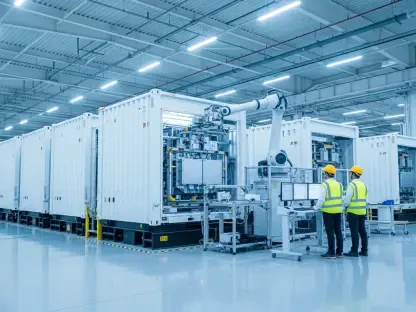In the rapidly evolving landscape of renewable energy, the United States stands at the cusp of a significant transformation in its energy storage capabilities. As industries and consumers increasingly lean into sustainable solutions, the shift away from traditional energy sources toward renewable alternatives has never been more evident. The U.S. Energy Information Administration (EIA) projects a substantial growth trajectory in utility-scale battery storage, driven by the need to store renewable energy efficiently and cater to rising electricity demand. With the estimated capacity set to triple within the next few years, this expansion signifies not only technological advancement but also a growing commitment to environmental sustainability and energy independence.
Drivers of Battery Storage Expansion
Transition from Traditional Energy Sources
The anticipated growth in battery storage aligns with the broader decline in reliance on natural gas-fired generation, a trend propelled by various market dynamics. Elevated natural gas prices have nudged utilities towards more economical energy sources, reinforcing the transition to renewables. As solar capacity continues to advance, its share in the overall energy mix grows, diminishing the dominance of traditional energy. This declining dependency on natural gas represents a calculated move by energy providers, bolstered by policy incentives and investment in renewable technology. In tandem, consumer preferences lean towards more sustainable options, prompting a reevaluation of traditional energy strategies.
Capacities in the renewable sector, particularly solar and hydroelectric power, show promising growth, reshaping the energy landscape. The EIA indicates a notable 33% increase in solar generation, driven by technological advancements and substantial investments in solar infrastructure. This augmentation not only satisfies current energy demands but also positions the sector as a pivotal player in future energy planning. Additionally, hydroelectric power is projected to increase by approximately 6%, a figure attributed to favorable water supplies in western states. These developments underscore a clear shift in priorities, where renewables increasingly usurp the spot traditionally held by fossil fuels.
Rising Demand in Industrial and Commercial Sectors
The projected demand surge for battery storage is also a reflection of the burgeoning needs of the commercial and industrial sectors. As data centers proliferate to support a digitally connected world, their energy requirements necessitate robust, scalable solutions. Battery storage emerges as a key enabler, offering reliability and efficiency to meet the sector’s unique energy profiles. Moreover, industries are progressively driven by sustainability commitments, adopting battery storage to mitigate carbon footprints and optimize operational efficiency.
This increased demand is evident in the expansion from around 100 MW to 300 MW of large-scale storage capacity in these sectors. This growth is not merely a response to immediate needs; it marks a strategic move towards future-proofing industrial capabilities. The synergy between technological advancement and strategic deployment empowers industries to anticipate and manage fluctuations in energy supply, maintaining operational resilience. As the U.S. economy continues to thrive on the back of technological innovation, battery storage becomes an indispensable part of the evolving industrial ecosystem.
Future Prospects for Renewable Energy Adoption
Insights into Projected Energy Output
The EIA’s forecasts for the upcoming years indicate a significant rise in U.S. electricity generation, suggesting a broader context of renewables adoption. Domestic electricity output is expected to escalate from 4,180 billion kWh to 4,490 billion kWh, mirroring the consistent integration of sustainable energy resources. This increase reflects not just market adaptations but a fundamental transformation in energy policy and infrastructure. It also hints at heightened renewable technology uptake across various segments, signaling a committed move toward environmental stewardship.
These projections highlight a critical narrative in the energy sector, emphasizing adaptability and expansion in renewable enterprise. The robust increase in renewable-driven electricity generation signifies a strategic shift, balancing immediate supply concerns with long-term environmental goals. As industries pivot to align with sustainable practices, this growing output underpins initiatives for enhanced energy efficiency and resource optimization. Policymakers and stakeholders must navigate this transition thoughtfully to harness its full potential while ensuring energy security and economic vitality.
Enhancing Infrastructure for a Sustainable Future
In the swiftly advancing realm of renewable energy, the United States is on the brink of a profound transformation concerning its energy storage capabilities. As both industries and consumers increasingly favor sustainable solutions, the pivot away from traditional energy sources towards renewable options has never been more pronounced. According to projections from the U.S. Energy Information Administration (EIA), utility-scale battery storage is expected to experience remarkable growth, prompted by the need to effectively store renewable energy and accommodate the burgeoning demand for electricity. This capacity is anticipated to triple within a relatively short timeframe, highlighting not only technological advancements but also a deepening commitment to environmental sustainability and energy independence. Such progress marks a vital step in addressing climate change and achieving a cleaner energy future, as the nation seeks to enhance its infrastructure to support these advancements and to reduce reliance on fossil fuels.









